Ever wondered about the difference between Turkish coffee and Arabic coffee? These two beloved brewing traditions might seem similar at first peek, but they each offer distinct flavors, preparation methods, and cultural significance that set them apart.
While both styles have ancient roots in Middle Eastern coffee culture, Turkish coffee is known for its uniquely fine grounds and sweet, unfiltered presentation, typically served in small cups with a layer of foam on top. Arabic coffee, on the other hand, features lighter roasts infused with cardamom and other spices, usually served in small handleless cups as a symbol of hospitality. Understanding these differences will help you appreciate the rich heritage behind each brewing tradition.
The Rich History of Turkish and Arabic Coffee
Turkish and Arabic coffee traditions stretch back centuries, each with distinct evolutionary paths that have shaped today’s cultural practices. These ancient brewing methods aren’t just about caffeine—they’re living artifacts of history, diplomacy, and social connection.
Origins and Cultural Significance
Turkish coffee emerged in the 16th century during the Ottoman Empire when coffee was introduced from Yemen to Istanbul. Sultan Suleiman the Magnificent’s court quickly embraced coffee, establishing the position of Chief Coffee Maker—an influential role that required exceptional brewing skills. Ottoman expansion spread this brewing style throughout Southeastern Europe, North Africa, and the Middle East, creating regional variations while maintaining the core preparation method.
Arabic coffee (qahwa) traces its roots to ancient Ethiopia and Yemen, where coffee cultivation began around the 15th century. Bedouin tribes across the Arabian Peninsula adopted coffee as a symbol of hospitality, developing elaborate rituals for its preparation and service. In Saudi Arabia, UAE, and other Gulf countries, serving Arabic coffee remains a ceremonial duty that demonstrates generosity and welcome. The coffee ceremony often includes burning incense and offering dates alongside the beverage.
Both traditions have earned UNESCO Intangible Cultural Heritage status—Turkish coffee culture in 2013 and Arabic coffee serving traditions in 2015—recognizing their cultural importance beyond mere consumption.
Traditional Brewing Methods
Turkish coffee brewing involves distinctive techniques that have remained largely unchanged for centuries. The preparation requires finely ground coffee beans (resembling powder), cold water, sugar (optional), and a special pot called a cezve or ibrik. The coffee grounds and water mixture is slowly heated until it foams but doesn’t boil, creating a thick, rich beverage with a characteristic foam layer called “kaymak.” This process is often repeated three times to achieve the perfect consistency.
Arabic coffee preparation differs significantly in both method and flavor profile. The beans are lightly roasted and coarsely ground, then boiled in a dallah (traditional coffee pot) with cardamom and sometimes other spices like saffron, cloves, or cinnamon. The brewing process includes multiple rounds of boiling and resting to extract flavors properly. Unlike Turkish coffee, Arabic coffee is typically filtered before serving to remove the grounds, resulting in a clearer beverage.
The distinctive serving rituals enhance both traditions. Turkish coffee arrives in small cups accompanied by a glass of water and often Turkish delight, while Arabic coffee is served from right to left in small handleless cups called finjans, filled only one-third full to allow quick consumption before it cools. The server continues refilling until the guest signals completion by wiggling the empty cup.
Brewing Techniques: How Turkish and Arabic Coffee Differ
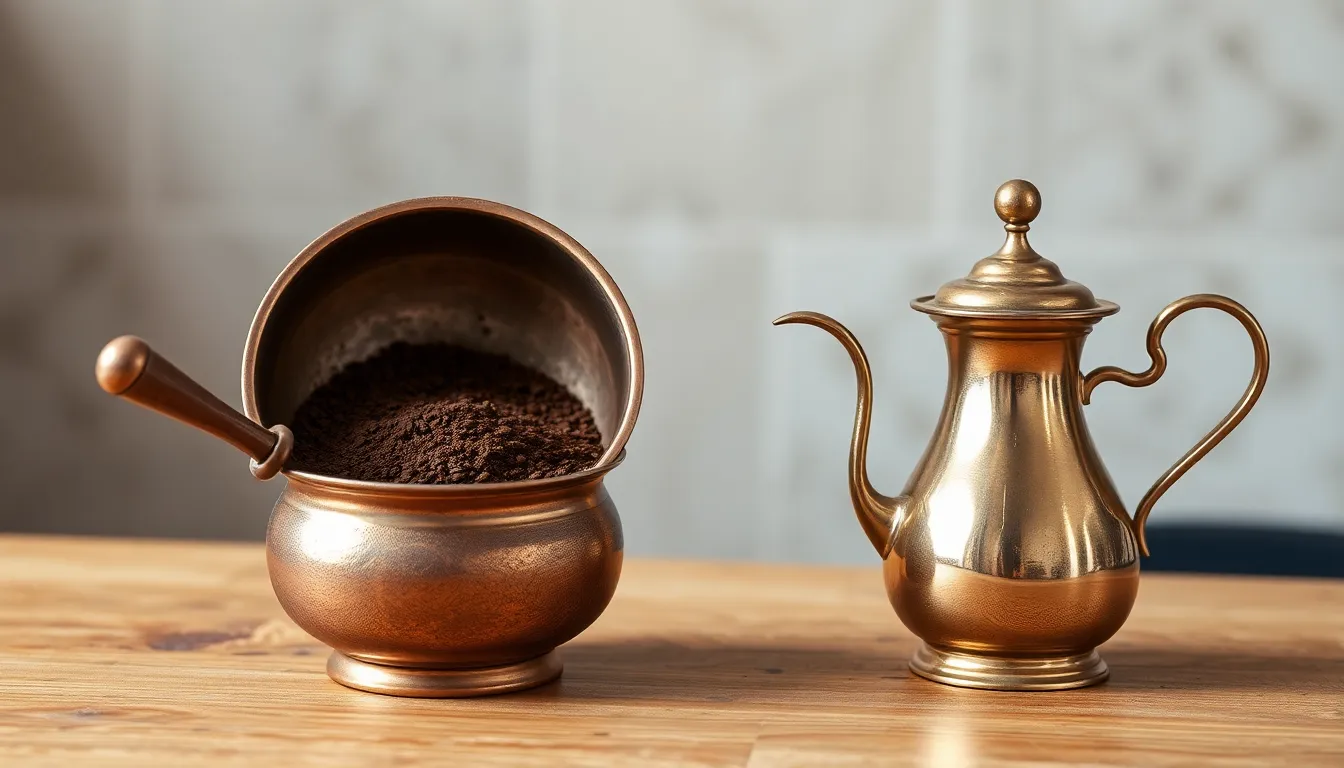
The brewing techniques for Turkish and Arabic coffee showcase distinct approaches that create their unique flavors and textures. Each method requires exact equipment, timing, and ingredients that have been perfected over centuries of tradition.
The Turkish Coffee Method
Turkish coffee brewing demands precision and patience for optimal results. The process begins with extremely finely ground coffee beans—much finer than espresso—that resemble powder in texture. A traditional copper pot called a cezve (or ibrik) forms the centerpiece of this brewing method, with its wide bottom and narrow neck designed to create the signature foam. Cold water combines with the coffee grounds and optional sugar directly in the cezve before heating slowly over low heat. The mixture requires careful attention as it’s brought to a boil three times, creating a thick, syrupy consistency with a dark foam layer on top. This meticulous boiling technique concentrates the flavor compounds and creates the characteristic rich mouthfeel that Turkish coffee enthusiasts prize. When served, the unfiltered brew settles in the cup, with grounds forming a dense layer at the bottom that’s never meant to be consumed.
The Arabic Coffee Preparation
Arabic coffee preparation embraces a lighter, more aromatic approach centered around spice integration. The process starts with lightly roasted beans that maintain their golden-brown color even after grinding. Unlike Turkish coffee’s powder-like consistency, Arabic coffee uses a less fine grind that allows for quicker extraction. A traditional dallah pot, typically made of brass or stainless steel with a distinctive curved spout, serves as the brewing vessel. Cardamom pods or ground cardamom take center stage in this preparation, often added directly to the water before the coffee grounds join the mix. Some regional variations incorporate additional spices like saffron, cloves, or rose water for complex flavor profiles. The brewing time remains relatively short compared to Turkish coffee, with a gentle simmer rather than repeated boiling. This technique produces a thinner, clearer beverage without the thick foam layer characteristic of Turkish coffee. The final brew offers bright, aromatic notes with a subtle bitterness balanced by the warming spices.
| Feature | Turkish Coffee | Arabic Coffee |
|---|---|---|
| Brewing Vessel | Cezve/Ibrik (copper pot) | Dallah (brass/steel pot) |
| Water Temperature | Brought to boil three times | Gently simmered once |
| Brewing Time | 7-10 minutes | 3-5 minutes |
| Grind Size | Ultra-fine powder | Medium-fine |
| Key Ingredients | Coffee, water, optional sugar | Coffee, water, cardamom, optional additional spices |
| Foam Presence | Thick, dark foam (crucial) | Minimal foam (not emphasized) |
| Filtering | Unfiltered | Unfiltered |
Bean Selection and Roasting Profiles

The distinctive character of both Turkish and Arabic coffee stems largely from their unique bean selection and roasting methods. These fundamental differences create entirely different flavor profiles and drinking experiences.
Turkish Coffee Beans
Turkish coffee relies on dark-roasted coffee beans with a deep brown color and firm texture. These beans undergo an intensive roasting process that develops their rich, robust flavor profile essential for the traditional preparation. Ground to an extremely fine powder-like consistency—finer than almost any other coffee preparation—Turkish coffee beans create the dense, syrupy texture that’s characteristic of this brew. This ultra-fine grind allows the coffee particles to fully integrate with water when brewed in a cezve or ibrik, producing that signature thick consistency. Adding sugar during preparation helps balance the natural bitterness of the dark roast, creating a harmonious sweet-bitter flavor that complements the coffee’s intensity.
Arabic Coffee Bean Varieties
Arabic coffee features a gentler approach to both roasting and grinding. The beans are typically light to medium-roasted, resulting in a pale yellowish or light brown color when ground. This milder roasting preserves more of the beans’ natural acidity and distinctive flavors, creating a base that pairs beautifully with added spices. Ground more coarsely than Turkish coffee, Arabic beans combine with cardamom, saffron, ginger, and cloves to create a uniquely aromatic brew. The coffee tends to be more bitter than its Turkish counterpart, with spices rather than sugar providing flavor complexity. This approach to roasting and flavoring creates a fragrant, distinctive coffee experience centered around the interplay between the coffee’s natural characteristics and the added spices.
| Feature | Turkish Coffee | Arabic Coffee |
|---|---|---|
| Roast Level | Dark roast (highly roasted) | Light to medium roast (gently roasted) |
| Grinding | Extremely fine powder | Coarser grind |
| Bean Color (Ground) | Dark brown | Pale brown to yellowish |
| Flavor Profile | Balanced sweet and bitter, rich | Bitter, aromatic with spices |
| Spices Added | Rarely, sugar often added | Frequently cardamom, saffron, cloves |
Flavor Profile Comparison

The distinct flavor profiles of Turkish coffee and Arabic coffee stem from their unique preparation methods and ingredients. These traditional brewing styles create beverages with dramatically different taste experiences even though sharing common coffee origins.
Turkish Coffee Taste Characteristics
Turkish coffee delivers a bold, concentrated flavor profile with remarkable depth and complexity. Its extremely fine, powder-like grind allows the coffee to dissolve almost completely during the slow brewing process in a cezve, creating a rich, full-bodied cup. This careful brewing method just below boiling point preserves delicate flavor compounds while developing a velvety, thick texture topped with characteristic creamy foam. Sugar added before brewing integrates seamlessly throughout the drink, creating a customizable bittersweet balance that complements the coffee’s natural earthiness. The unfiltered brewing process leaves fine grounds in the cup, contributing to Turkish coffee’s distinctively thick mouthfeel that coats your palate with each sip.
Arabic Coffee Flavor Notes
Arabic coffee presents a milder, more aromatic experience compared to its Turkish counterpart. The signature taste comes from fragrant spices like cardamom and saffron, which infuse the coffee during or after brewing. These spices create a delicate, soothing character rather than overwhelming boldness. Arabic coffee features less density and bitterness than Turkish varieties, focusing instead on smooth, refined flavor notes. The spice blend transforms what would be a simple coffee into a complex, fragrant beverage that engages multiple senses. Coffee enthusiasts appreciate Arabic coffee primarily for its aromatic qualities and subtle spice integration rather than the intense strength found in Turkish preparations.
Serving Traditions and Rituals
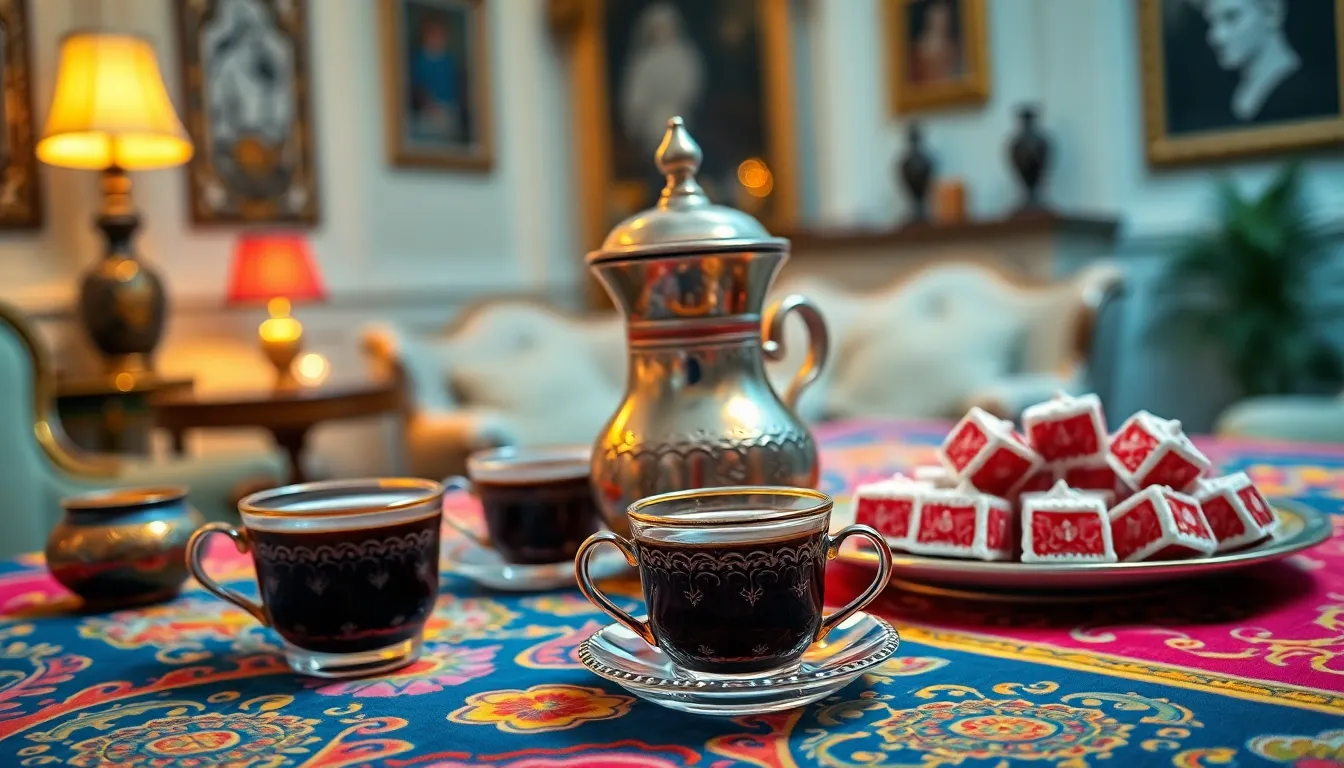
Coffee rituals transcend mere beverage consumption in both Turkish and Arabic cultures, embodying centuries of tradition and social connection. These distinctive customs reflect deep cultural values and offer a window into the soul of these coffee-loving societies.
Turkish Coffee Serving Traditions
Turkish coffee ceremonies represent important social rituals deeply embedded in daily life. The coffee is meticulously prepared in a specialized pot called a “cezve” or “ibrik,” where finely ground, dark roasted coffee slowly boils three times to create a thick, frothy brew. Sugar additions occur during the preparation process according to guest preferences. A proper Turkish coffee presentation includes a layer of foam on top, considered essential for indicating quality preparation. Social gatherings featuring Turkish coffee often extend beyond drinking to include animated conversations and the traditional practice of fortune-telling from the remaining grounds at the cup’s bottom.
Arabic Coffee Hospitality Customs
Arabic coffee (qahwa) stands as the ultimate symbol of generosity and welcome in Arab culture. Hosts brew this special coffee in a “dallah,” a distinctive copper or brass pot where lightly roasted beans simmer with aromatic spices like cardamom, saffron, ginger, and cloves. The serving ritual follows precise protocols—the host pours coffee for the eldest or most honored guest first, filling only a small portion of their “finjan” (small, elongated cup). Multiple refills during a visit demonstrate continued hospitality, while guests signal completion by gently shaking their cups. The thin, light-textured coffee offers a bitter, spice-forward flavor profile without added sugar. This elaborate serving ceremony transcends simple refreshment, functioning as a cornerstone of social connection and respect throughout the Arab industry.
Turkish Coffee Cups and Presentation
Turkish coffee cups feature distinctive designs that enhance the overall experience. These small, round porcelain or ceramic vessels typically come without handles and help maintain ideal drinking temperature. Turkish cups appear noticeably larger than their Arabic counterparts and often form part of ornate coffee sets displayed with pride in many homes. The presentation typically includes a glass of water alongside the coffee to cleanse the palate before sipping. Many hosts serve Turkish coffee with sweet accompaniments like Turkish delight or baklava, creating a pleasant contrast to the coffee’s robust flavor. The characteristic dense grounds that settle at the bottom serve both practical and mystical purposes—they’re avoided while drinking and later used for fortune-telling, adding an element of future-gazing to this rich tradition.
Arabic Coffee Hospitality Customs
Arabic coffee customs follow elaborate protocols that have remained largely unchanged for centuries. The “finjan” cups used for serving feature elongated shapes specifically designed for comfortable handling even though containing hot liquid. A proper Arabic coffee service involves multiple visual cues and non-verbal communication—hosts remain standing while serving, continuously monitoring guests’ cups for emptying. The serving order follows strict social hierarchies, moving from right to left after the most honored guest receives the first cup. Hosts typically pour small amounts, encouraging conversation through frequent refills rather than long drinking sessions. Coffee preparation occurs in full view of guests in many settings, transforming the brewing process itself into part of the entertainment and hospitality experience. These detailed customs surrounding Arabic coffee have earned recognition from UNESCO as an Intangible Cultural Heritage, acknowledging their significance beyond mere refreshment.
Reading the Grounds: Fortune Telling Traditions
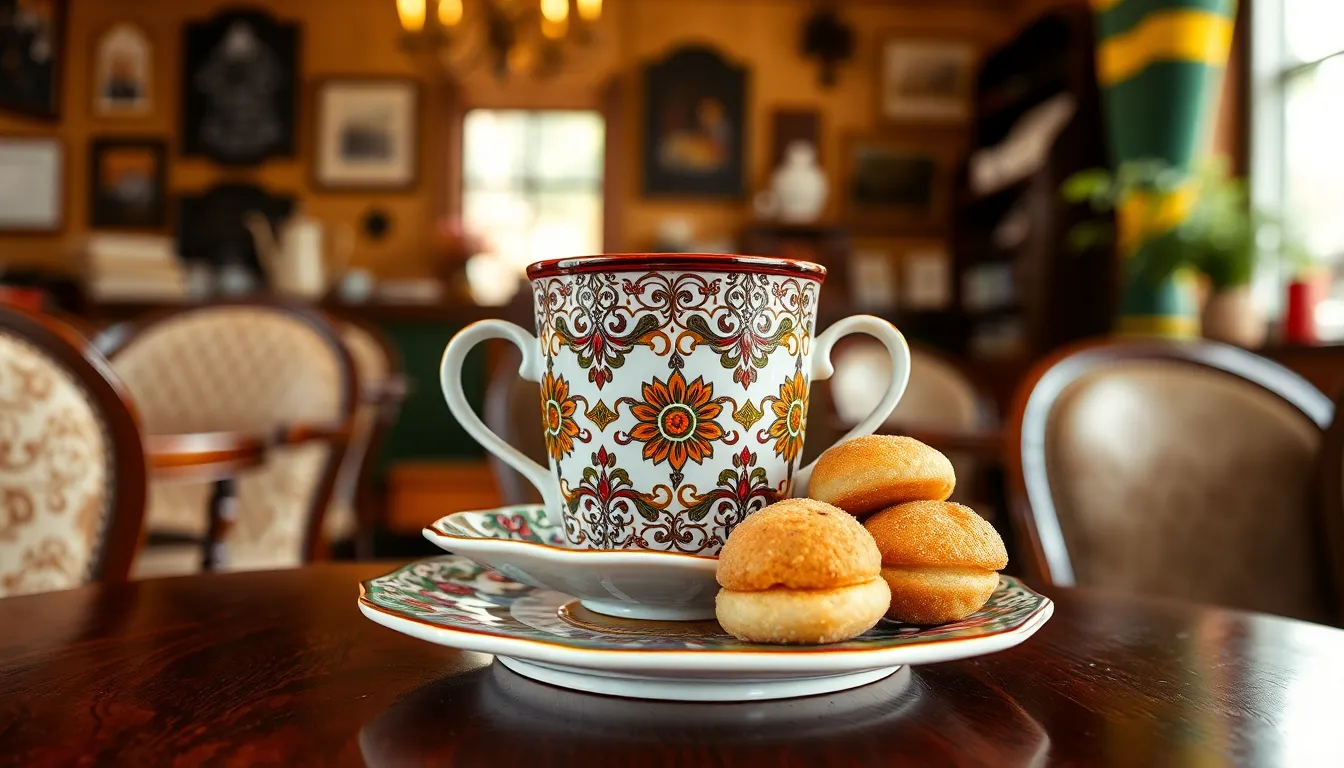
Turkish coffee fortune-telling, known as “tasseography” or “tasseomancy,” represents one of the most fascinating cultural traditions associated with coffee consumption. After drinking Turkish coffee, the cup is turned upside down on the saucer to cool, leaving patterns of grounds that skilled interpreters analyze to predict the future. These intricate patterns form symbols, shapes, and figures that carry exact meanings about love, career, and life events.
Arabic coffee, while sharing the unfiltered preparation method that leaves grounds in the cup, doesn’t traditionally incorporate the same fortune-telling practices. The lighter roast and coarser grind of Arabic coffee creates fewer distinctive patterns, making it less suitable for divination practices. Cultural attitudes toward fortune-telling also differ across regions, with some Arab communities viewing such practices as inconsistent with religious beliefs.
Fortune-telling with Turkish coffee gained popularity during the Ottoman Empire, spreading throughout the Mediterranean and Middle East. The practice creates an intimate social experience where friends gather to share not just coffee but also glimpses into their potential futures. Many Turkish households still maintain this tradition during social gatherings, with the most experienced family member often taking the role of interpreter.
The symbolism in Turkish coffee readings follows exact guidelines. Shapes appearing near the rim of the cup indicate events in the immediate future, while those at the bottom suggest distant outcomes. Animals, numbers, and geometric shapes each carry distinct meanings – birds symbolize good news, while snakes might warn of betrayal or challenges ahead.
Modern Turkish coffee shops often include fortune-telling services, keeping this centuries-old tradition alive for tourists and locals alike. Professional readers may charge for their interpretations, which typically last 15-30 minutes per cup. The enduring popularity of this practice demonstrates how coffee traditions extend beyond mere consumption to create meaningful cultural experiences that connect past and present.
Modern Adaptations and Global Influence
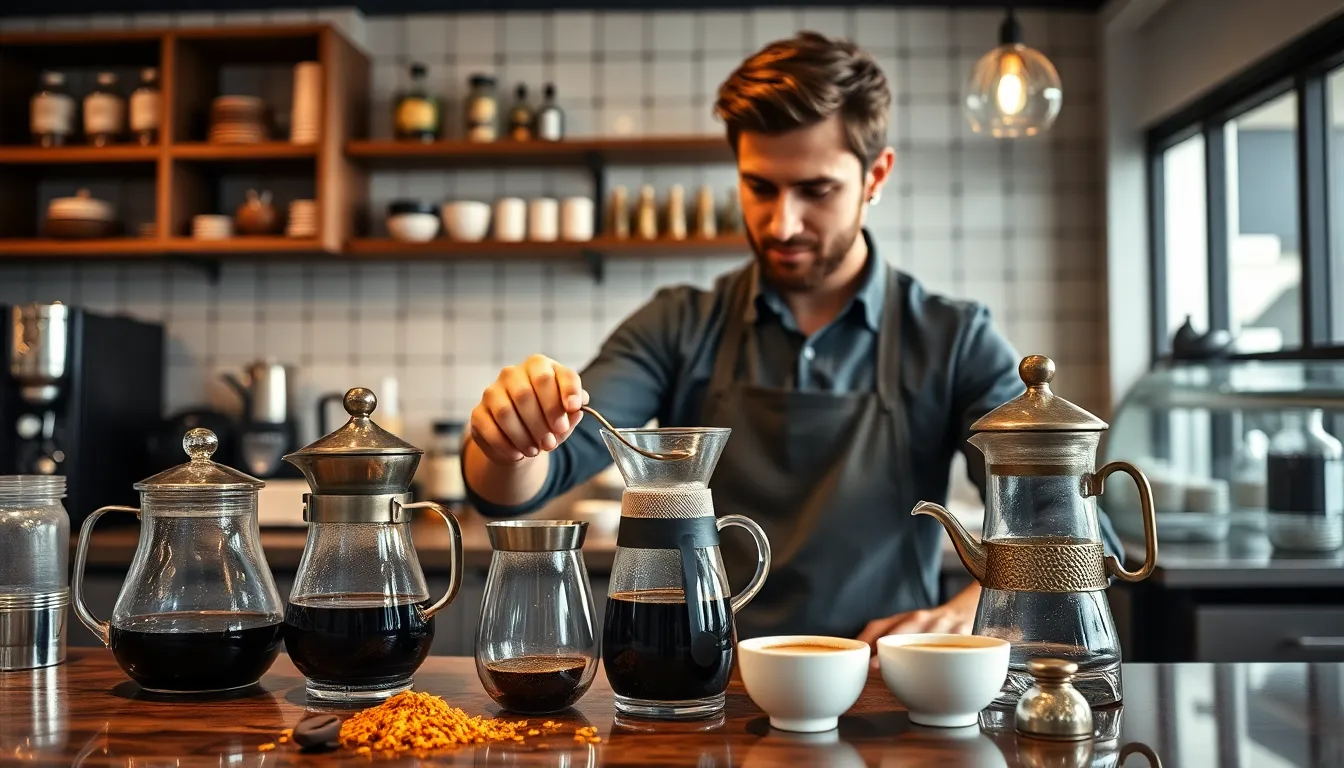
Turkish and Arabic coffee traditions have evolved significantly to accommodate contemporary tastes while maintaining their cultural essence. These time-honored brewing methods now coexist with innovative techniques that appeal to modern coffee enthusiasts worldwide.
Arabic Coffee Innovations
Arabic coffee has transcended its traditional serving customs to appear in sophisticated coffee shops around the globe. Creative baristas now incorporate its distinctive spice profiles into espresso variations that combine centuries-old flavors with contemporary preparation methods. Cold brew versions infused with cardamom, saffron, and cloves offer refreshing alternatives during warmer months. These modern interpretations make Arabic coffee’s unique taste profile accessible to younger generations while preserving its cultural significance.
Turkish Coffee’s Evolution
Turkish coffee has embraced technology and flavor experimentation to remain relevant in today’s fast-paced industry. Electric Turkish coffee makers now provide consistent results for those seeking convenience without sacrificing authenticity. Flavored syrups including vanilla, caramel, and hazelnut enhance the traditional taste while expanding its appeal to diverse palates. Turkish coffee cocktails have emerged in trendy establishments, combining the rich, robust brew with spirits to create sophisticated adult beverages that introduce this ancient tradition to new audiences.
Cultural Impact Beyond Borders
Both coffee traditions represent more than mere beverages—they embody rich cultural histories that symbolize hospitality and social connection. As global interest in specialty coffee grows, Turkish and Arabic coffee preparation methods offer unique sensory experiences that stand apart from mainstream coffee culture. Their distinctive brewing techniques, aromatic profiles, and ceremonial aspects provide coffee lovers with authentic alternatives to standardized commercial offerings.
This ongoing evolution ensures these traditional coffee styles maintain their cultural identity while adapting to contemporary preferences. Coffee enthusiasts worldwide now appreciate the nuanced differences between Turkish coffee’s rich, slightly sweetened profile with its characteristic thickness and Arabic coffee’s spiced, aromatic complexity. Through this blend of tradition and innovation, these ancient coffee cultures continue to influence and enrich the global coffee industry.
Health Benefits and Considerations
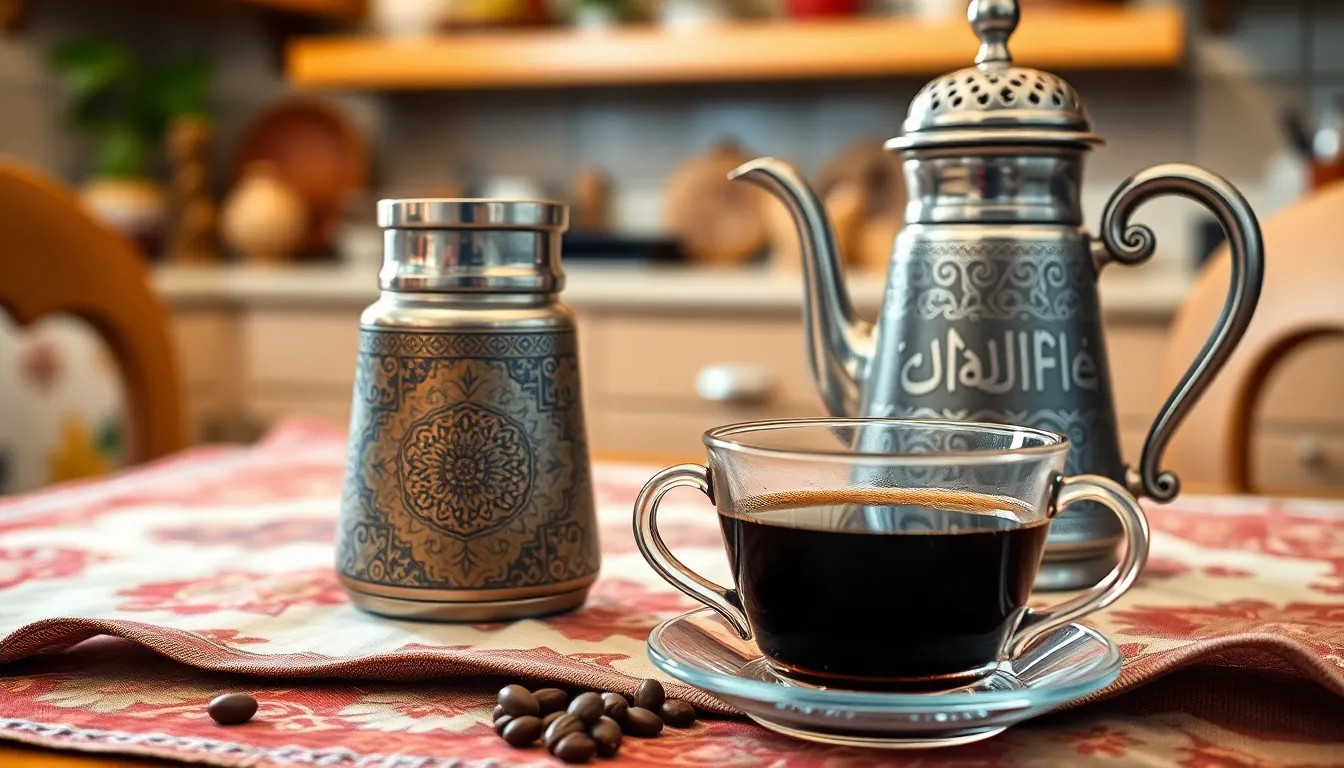
Turkish and Arabic coffee each offer unique health benefits thanks to their distinct preparation methods and ingredients. Both varieties contain beneficial antioxidants that combat oxidative stress and potentially reduce the risk of chronic diseases. The caffeine present in each enhances mental alertness and focus, making them popular morning beverages across cultures. Traditionally, these coffees are consumed after meals to aid digestion, a practice that continues today.
Turkish coffee delivers a stronger caffeine punch due to its extremely fine grind and complete brewing process that incorporates all coffee solids. Its dark roasted beans create a rich, concentrated brew with a thick texture that’s customarily sweetened according to taste. This sweetening affects calorie intake and blood sugar levels, something to consider if you’re monitoring your sugar consumption. The intense roasting process that gives Turkish coffee its bold flavor may produce more acrylamide, a potential carcinogen when consumed in high amounts.
Arabic coffee takes a gentler approach with its lightly roasted beans and coarser grind. It’s typically prepared with a blend of spices including cardamom, saffron, ginger, and cloves, which contribute additional antioxidant and anti-inflammatory properties. The lighter roast preserves more of the coffee bean’s natural compounds while providing a milder caffeine content. Arabic coffee is traditionally served unsweetened, eliminating added sugar concerns while offering unique health benefits from its aromatic spices that may improve metabolism and enhance digestive function.
The choice between Turkish and Arabic coffee isn’t just about flavor preferences but also health considerations. Turkish coffee provides a robust, customizable coffee experience with options for sweetness, while Arabic coffee offers a spiced, usually unsweetened alternative with distinctive benefits from its herbal additions. Each tradition represents a unique approach to coffee consumption that balances enjoyment with varying health attributes.
Conclusion
Both Turkish and Arabic coffee represent more than just beverages – they’re gateways to rich cultural traditions that have thrived for centuries. Whether you’re drawn to the intense boldness of Turkish coffee with its fortune-telling rituals or the aromatic spiced elegance of Arabic coffee with its hospitality customs you’re participating in a living heritage.
As these traditions continue evolving in our modern industry they maintain their distinctive preparation methods cultural significance and unique flavor profiles. You can appreciate both for their individual merits while understanding how they reflect the values and history of their respective cultures.
The next time you enjoy either coffee remember you’re not just tasting a beverage but experiencing centuries of tradition in each sip.
Frequently Asked Questions
What are the main differences between Turkish coffee and Arabic coffee?
Turkish coffee features finely ground dark-roasted beans prepared in a cezve, resulting in a thick, unfiltered beverage with foam. It’s typically sweetened and served in small cups. Arabic coffee uses lightly roasted beans with cardamom, prepared in a dallah for a clearer, more aromatic drink. It’s served in handleless cups and represents hospitality in Arab culture.
How is Turkish coffee prepared traditionally?
Turkish coffee is made by combining extremely fine coffee grounds with water and optional sugar in a special pot called a cezve. The mixture is brought to a boil three times to create a rich consistency with thick foam. This precise method results in a concentrated, syrupy beverage that’s served unfiltered with the grounds settling at the bottom of the cup.
What spices are typically used in Arabic coffee?
Cardamom is the primary spice used in Arabic coffee, giving it its distinctive aromatic quality. Some regional variations may also include saffron, cloves, or cinnamon. These spices are often added during the brewing process in a dallah (traditional coffee pot), resulting in a fragrant beverage that engages multiple senses through its complex flavor profile.
What is the cultural significance of Turkish coffee?
Turkish coffee represents social connection and diplomacy, dating back to the 16th century Ottoman Empire. UNESCO recognized it as an Intangible Cultural Heritage in 2013. The elaborate preparation and serving rituals create meaningful social experiences, while the tradition of fortune-telling from coffee grounds (tasseography) adds a mystical dimension that connects past and present generations.
How is Arabic coffee traditionally served?
Arabic coffee is served in small handleless cups called finjans from a dallah (traditional pot). The server follows specific protocols, starting with the eldest or most honored guest and using the right hand only. Cups are filled one-third full and refilled frequently to demonstrate hospitality. Guests signal they’ve had enough by wiggling the cup when returning it.
What is tasseography and how does it relate to Turkish coffee?
Tasseography is the practice of fortune-telling by interpreting patterns formed by coffee grounds. After drinking Turkish coffee, the cup is inverted onto a saucer, allowing the grounds to create patterns. A skilled interpreter then “reads” these patterns to predict the drinker’s future. This tradition has been popular since the Ottoman Empire and creates an intimate social experience that extends beyond coffee consumption.
Can people with caffeine sensitivity enjoy Turkish or Arabic coffee?
Both coffees can be adapted for caffeine-sensitive individuals. Arabic coffee is naturally lower in caffeine due to its lighter roast and is sometimes made with decaffeinated beans. Turkish coffee, despite its intense flavor, can also be prepared with decaffeinated grounds while maintaining its traditional preparation method. The key is to inform your host or barista about your caffeine sensitivity.
Are Turkish and Arabic coffees healthier than regular coffee?
Both coffee traditions offer health benefits through antioxidants and metabolism-boosting properties. Arabic coffee, typically unsweetened and infused with cardamom, may aid digestion and provide anti-inflammatory benefits. Turkish coffee contains beneficial compounds but can be high in calories when sweetened. The unfiltered nature of both coffees preserves more natural coffee oils and beneficial compounds than filtered varieties.
How have these traditional coffees evolved in modern times?
Both coffees have adapted to contemporary tastes while preserving their cultural essence. Electric Turkish coffee makers now offer convenience without sacrificing quality. Arabic coffee has inspired specialty drinks in global cafés, with its spice profiles incorporated into espresso variations and cold brews. Modern presentations may include flavored syrups or alternative sweeteners while maintaining the distinctive brewing methods that define these traditions.
Which is stronger, Turkish coffee or Arabic coffee?
Turkish coffee is generally stronger in both flavor and caffeine content due to its dark roast, extremely fine grind, and concentrated brewing method. The result is a bold, intense coffee experience. Arabic coffee, with its lighter roast and addition of spices, offers a milder, more aromatic profile that emphasizes refined flavors over strength. The experience depends on what you define as “strong” – intensity or complexity.


























